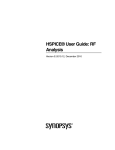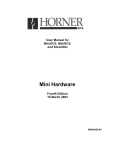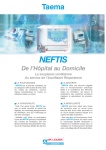Download GOLDEN SAMPLE IDENTIFICATION USING CLIO AND SCILAB
Transcript
AN-006 APPLICATION NOTE AUDIOMATICA GOLDEN SAMPLE IDENTIFICATION USING CLIO AND SCILAB by Daniele Ponteggia - [email protected] INTRODUCTION The efficiency and quality of a manufacturing process can be kept under control through measurements on production items. Every production process is unique and reflects the history and philosophy of a company. This asks for flexible analysis tools tailored to the specific production needs. In this application note we will show some practical examples of statistical analysis on sets of measurements that can be useful in QC management, such as the identification of the golden sample. The analysis is usually done on a statistically relevant number of samples. This means a sufficiently large set of electrical or acoustical measurements, as an example frequency responses, to be analyzed. While it is possible to include such kind of tools into a QC measurement software, this approach may be not sufficiently flexible. We found out that it is possible to create powerful analysis tools by complementing a reliable and programmable QC system (CLIO) with a general purpose numerical computation software (Scilab). Figure 1: Typical production process with Quality Control AN-006/1111 1/15 GOLDEN SAMPLE IDENTIFICATION USING CLIO AND SCILAB This application note is divided in three sections. First we will show how to use Scilab to import CLIO frequency responses saved in .txt file format, then two practical applications are presented in detail: how to search the golden sample in a set of measured items, and how to find if in a production there are items that match the golden sample properties and that can be used as substitutes for the actual golden sample. Together with the application note, there are two compressed .zip folders (goldensample.zip and goldenmatch.zip) with the example Scilab scripts and sample data in order to experience with the scripting process. The files should available for download in the www.audiomatica.com Tech Support section web site. SCILAB AS ANALYSIS TOOL Scilab (www.scilab.org) is an open source numerical computation software. Scilab syntax is simple and similar to the “industry standard” Matlab software. The learning curve of the software is not steep and plenty of examples are available through Internet and on-line documentation. Scilab is very powerful in the analysis of sets of measurements: data is stored and manipulated in vector/matrices, statistical and processing functions are already present as high-level commands and a powerful plotting library is available. Files created by the CLIO system are either in binary or text format. In the following examples we will use frequency response CLIO .txt files. Such kind of files are simple three column text with frequency, level and phase. We show briefly a simple example of Scilab commands to load a CLIO .txt frequency response file and create a log-lin plot. Suppose that we start with a CLIO .txt file (which in this example is named “response.txt”) that contains a frequency response with 64 frequency points, one on each row of the file with a triplet: frequency, sound pressure level and phase. Freq Freq [Hz] [Hz] 10.00 10.00 11.28 11.28 12.73 12.73 14.35 14.35 16.19 16.19 dBSPL dBSPL 61.05 61.05 61.47 61.47 62.33 62.33 63.35 63.35 64.54 64.54 Phase Phase [Deg] [Deg] 91.76 91.76 86.60 86.60 76.61 76.61 66.21 66.21 55.57 55.57 95.10 95.10 94.69 94.69 93.65 93.65 95.66 95.66 96.60 96.60 95.16 95.16 -56.17 -56.17 15.37 15.37 17.48 17.48 -69.29 -69.29 77.42 77.42 109.52 109.52 […] […] 10841.56 10841.56 12229.84 12229.84 13795.90 13795.90 15562.49 15562.49 17555.30 17555.30 19803.29 19803.29 Figure 2: CLIO frequency response .txt file Using the Scilab command fscanfMat it is possible to read the file into a 64x3 matrix. Please consult the Scilab help to get detailed information on Scilab commands syntax. 2/15 www.audiomatica.com GOLDEN SAMPLE IDENTIFICATION USING CLIO AND SCILAB The command can be executed directly from the Scilab console (please check that the file is located in the current Scilab working directory): -->M=fscanfMat('response.txt'); The command parse the “response.txt” file stripping the first line, which is the file text header, and stores the data in a matrix M of dimensions 64x3 (rows x columns). The first column of the M matrix contains the frequency points, the second column the sound pressure level and the third the phase. Here is the matrix as imported by Scilab: -->M M = 10. 11.28 12.73 14.35 16.19 [...] 10841.56 12229.84 13795.9 15562.49 17555.3 19803.29 61.05 61.47 62.33 63.35 64.54 91.76 86.6 76.61 66.21 55.57 95.1 94.69 93.65 95.66 96.6 95.16 - 56.17 15.37 17.48 - 69.29 77.42 109.52 The command loads into the M matrix the three columns of data from the .txt file. Frequency, level and phase are stored in the matrix columns and are accessible as vectors: Frequency Sound Pressure Level Phase f i i =1…64 ∣H ( f i )∣ i=1… 64 arg {H ( f i ) } i=1…64 M(1:64,1) M(1:64,2) M(1:64,3) Plotting the data with Scilab is also very simple. Here is a basic sequence of commands to plot the frequency response log-lin graphic in figure 3. First of all the plot is created with the command: -->plot2d(Mread(:,1),Mread(:,2),2); Then some properties of the graphics are handled in order to get the desired result: -->a=gca(); -->a.log_flags=”lnn”; -->a.grid=[3,3]; -->a.box=”on”; For a detailed description of Scilab graphics, please consult the Scilab documentation. 3/15 www.audiomatica.com GOLDEN SAMPLE IDENTIFICATION USING CLIO AND SCILAB Figure 3: Frequency response plotted with Scilab Besides the possibility to execute commands from the console, Scilab has an editor for creating and executing script commands. Therefore it is possible to create analysis procedures in a simple way, while having an high degree of customization. Files in CLIO binary format can also be easily handled with Scilab, please check our Application Note 001 “CLIO 10 sinusoidal file structure with import examples in Scilab” which is available on our website www.audiomatica.com. GOLDEN SAMPLE SEARCH The search for the golden sample is a critical issue in the quality control process. The golden sample can be defined in product testing as: “[...] a sample that has all test results in the middle of the nominal range”. Every manufacturing process can have a different strategy for this search, here we show only a possible solution using CLIO and Scilab. In our example we deal with a production batch of microphones, we try to find the golden sample among this batch by searching the item which is nearest the average frequency response (magnitude only) in a specified range. First the frequency response of every microphone of the batch is collected by placing it in front of a reference loudspeaker driver, taking great care of the repeatability of the positioning against the transducer 1. Since every microphone capsule can have a different sensitivity, we calculate the sensitivity of each microphone in a given frequency range (500 Hz – 2 kHz) and then apply a correction in order to align the frequency response to a reference value. The entire set of collected responses is shown in figure 4. 1 The repeatability and reproducibility of a measurement setup it is a topic in itself. We would not enter here into the details, but it must be noted that if the repeatability of the measurement is not sufficiently granted, most of the statistical analysis that is described here is meaningless. 4/15 www.audiomatica.com GOLDEN SAMPLE IDENTIFICATION USING CLIO AND SCILAB Figure 4: Original set of measured data Figure 5: Reduced (purged) set of data Next we calculate the average value and standard deviation of the magnitude frequency response. Our research policy requires, at this point, to discard items whose response exceed the average response (bold red curve) plus/minus two times the standard deviation (thin red curves). We end up with a new (reduced) set of microphones where the items with a frequency response which deviates too much from the average (outliers) are discarded (Figure 5). At this stage the average frequency response is calculated again on the new set 5/15 www.audiomatica.com GOLDEN SAMPLE IDENTIFICATION USING CLIO AND SCILAB (shown in bold red curve) and a research of the item with minimum deviation (in a frequency range 200 Hz – 16 kHz) from the average is carried out. The item that has less deviation from the average is the golden sample (bold green in figure 5, not easily visible because overlaps with the average red curve). The golden sample search process can be implemented with a fairly simple Scilab script. We analyze here the code in depth. The head of the script has only comments and a brief description of the script itself: // // // // // // // // // // goldensample.sce Load responses in CLIO .txt format from a folder and search for the Golden Sample fming,fmaxg normsens fmins,fmaxs purgeout stdpurge - analysis frequency range =1 sensitivity normalization sensitivity frequency range =1 purge outliers std purge multiplier Memory and already present graphic windows needed to be cleared: clear; //clear memory lines(0); //avoid console output halt //closes all open graphic windows wins=winsid(); for w=wins xdel(w); end Then the settings must be edited to meet the golden sample search needs: //Analysis settings fming=200; fmaxg=16000; normsens=1; fmins=500; fmaxs=2000; purgeout=1; stdpurge=3; The response .txt files that are present in the current active Scilab folder 2 are loaded in memory: //Load frequency responses from CLIO .txt files S=dir('*.txt'); filelist=S(2); for i=1:size(filelist,1) do measname(i)=filelist(i); Mread=fscanfMat(measname(i)); measfreq(i,:)=Mread(:,1)'; 2 If the script is loaded double clicking on it in the Windows Explorer, the active Scilab folder becomes automatically the script folder. 6/15 www.audiomatica.com GOLDEN SAMPLE IDENTIFICATION USING CLIO AND SCILAB end measresp(i,:)=Mread(:,2)'; Please note that in this case only the first two columns of each imported file are used, phase data is discarded. The data is stored in two matrices measfreq and measresp with as many rows as the number of measurements m , and with a number of columns equal to the number of points n on each measurement3. Sound Pressure Level measfreq() f i i =1…n Frequency ∣H j ( f i )∣ M(1:64,2) i=1…64 If normalization is set the following code is executed. Thanks to the native matrix processing of Scilab the operation requires a very simple code. //if normsens then apply normalization if normsens==1 then [errval,fmini]=min(abs(measfreq(1,:)-fmins)); [errval,fmaxi]=min(abs(measfreq(1,:)-fmaxs)); meassens=mean(measresp(:,fmini:fmaxi),2); measresp=measresp-meassens.*.ones(1,size(measresp,2)); end fmini and fmaxi are the indexes of the frequency vector measfreq bounded by the fmins and fmaxs sensitivity range. meassens is a m size vector with the calculated sensitivities S j of each measured response measresp as the average sound pressure level in the sensitivity range. i =f maxi ∑ ∣H j (f i )∣ S j= i =f mini f maxi −f mini+1 ∀j Once the sensitivities are calculated, the responses are normalized. The following code plot the set of loaded responses: //plot frequency response set (after normalization) f=scf(); drawlater(); for i=1:size(measname,1) do plot2d(measfreq(i,:),measresp(i,:),2); end a=gca(); a.box="on"; atmax=ceil(max(measresp)/10).*10; a.data_bounds=[20,atmax-50;20000,atmax]; a.tight_limits="on"; a.log_flags="lnn"; 3 Due to this simplified approach, every measurement .txt file that is loaded must have the same number of points. The script do not provide any check on dimensions, failing to provide .txt files with a consistent number of fre quency point will lead to errors. 7/15 www.audiomatica.com GOLDEN SAMPLE IDENTIFICATION USING CLIO AND SCILAB a.grid=[3,3]; if normsens==1 then titlestring="Loaded Responses - Normalized "+string(fmins) +"Hz-"+string(fmaxs)+" Hz"; else titlestring="Loaded Responses"; end title(titlestring); xlabel("frequency (Hz)"); ylabel("level (dB)"); drawnow(); The following script computes the statistics of the data set: //compute statistics measmean=mean(measresp,1); measdstd=stdev(measresp,1); Frequency limits of the golden sample search are converted to indexes of the measfreq arrays: //golden sample search frequency range [errval,fmini]=min(abs(measfreq(1,:)-fming)); [errval,fmaxi]=min(abs(measfreq(1,:)-fmaxg)); If purgeout is selected, the responses outside the average plus/minus given times of the standard deviation are removed from the data set. The curves of the outliers are plotted in green and the measurement names are displayed on the Scilab console: //if purgeout then find and purge outliers drawlater(); measOK=[]; if purgeout==1 then plusstd=measmean+stdpurge.*measdstd; minustd=measmean-stdpurge.*measdstd; plot2d(measfreq(1,:),plusstd,3); plot2d(measfreq(1,:),minustd,3); j=1; for i=1:size(measname,1) do if (sum(measresp(i,fmini:fmaxi)>plusstd(fmini:fmaxi))+sum(measresp(i,fmini:fmaxi)<minustd(fmini:fm axi)))==0 then measOK(j)=i; j=j+1; else plot2d(measfreq(1,:),measresp(i,:),1); disp(measname(i)+" DISCARDED") end end else measOK=(1:size(measfreq,1))'; end drawnow(); 8/15 www.audiomatica.com GOLDEN SAMPLE IDENTIFICATION USING CLIO AND SCILAB if measOK==[] then disp("Purge excess!!!"); abort; end The purge code returns a vector measOK which contains the indexes of the “good” curves, the vector will be used later on to extract a reduced set of measurements. Finally the average value is plot in bold red, this curve is plotted as last to stay on top of the other curves (see figure 4): //plot statistics plot2d(measfreq(1,:),measmean,3); e=gce(); e.children(1).thickness=3 The statistics are calculated again on the reduced data set: //recompute statistics measmean=mean(measresp(measOK,:),1); measdstd=stdev(measresp(measOK,:),1); And finally the search of the golden sample is carried out: //golden sample research //compute difference between average and whole set of measurements measerro=measresp(:,:)-ones(size(measresp(:,:),1),1).*.measmean; //compute sum of squared errors and find minimum between valid items (golden) [errval,igolden]=min(sum(measerro(measOK,fmini:fmaxi).^2),2); igolden=measOK(igolden); //show golden disp(measname(igolden)+" GOLDEN SAMPLE"); For each item and for each frequency point the algorithm computes the difference between measured data and the set average and store it in the measerro matrix. Then a squared sum of the measerro matrix along the frequency points dimension is carried out, this results in a vector with dimension equal to the number of items of the set. i=f maxi ErrVal j = 2 ∑ [∣H j ( f i )∣−H mean ( f i ) ] i=f ∀ j ∈measOK mini A research of the index with the minimum of this vector returns directly the index igolden of the golden sample, and the name of the item measurement is displayed in the Scilab console. The response of the golden sample and the data set is plot with the following commands: //plot frequency response set with golden sample f=scf(); drawlater(); for i=1:size(measOK,1) do 9/15 www.audiomatica.com GOLDEN SAMPLE IDENTIFICATION USING CLIO AND SCILAB plot2d(measfreq(1,:),measresp(measOK(i),:),2); end plot2d(measfreq(1,:),measmean,3); e=gce(); e.children(1).thickness=3 plot2d(measfreq(igolden,:),measresp(igolden,:),5); e=gce(); e.children(1).thickness=3 a=gca(); a.box="on"; atmax=ceil(max(measresp)/10).*10; a.data_bounds=[20,atmax-50;20000,atmax]; a.tight_limits="on"; a.log_flags="lnn"; a.grid=[3,3]; title("Analyzed Responses"); xlabel("frequency (Hz)"); ylabel("level (dB)"); drawnow(); The error between the items of the data set and the item choose as the golden sample can be easily calculated and plotted: //compute error from golden golderro=measresp(:,:)-ones(size(measresp(:,:),1),1).*.measresp(igolden,: ); //plot error against golden sample f=scf(); drawlater(); for i=1:size(measOK,1) do plot2d(measfreq(1,:),golderro(measOK(i),:),2); end plot2d(measfreq(igolden,:),golderro(igolden,:),5); e=gce(); e.children(1).thickness=3 a=gca(); a.box="on"; atmax=ceil(max(golderro)/5).*5; a.data_bounds=[20,-atmax;20000,atmax]; a.tight_limits="on"; a.log_flags="lnn"; a.grid=[3,3]; title("Error Against Golden Sample"); xlabel("frequency (Hz)"); ylabel("level (dB)"); drawnow(); An example of this latest plot is shown in figure 6. The relative error of each item response against the golden sample can be useful to identify limit curves in a QC procedure. 10/15 www.audiomatica.com GOLDEN SAMPLE IDENTIFICATION USING CLIO AND SCILAB Figure 6: Relative error against golden sample GOLDEN SAMPLE MATCH One of the problems of using a physical golden sample is the conservation of the item. Due to aging or any accidental damage the golden sample may become unusable. Identification of possible substitutes for the golden sample during production it is a very interesting feature. Using Scilab it is possible to create a script which seeks for golden sample candidates in a production batch. REF. UNIT MEAS DATA SCILAB Analisys Script PROD. ITEM SET OF POSSIBLE GOLDEN SAMPLE SUBSTITUTES Figure 7: Golden Sample Match Process The golden sample match process act as in figure 7: a batch of items is tested during the QC execution, then the measured data is compared against the reference (golden sample) unit. The Scilab script calculates the error between each sample of the batch and the reference, then finds the candidates according to a specified criteria. In this example the criteria is the sum of the absolute error against the response of the reference, normalized by the number of frequency points. 11/15 www.audiomatica.com GOLDEN SAMPLE IDENTIFICATION USING CLIO AND SCILAB i=f maxi SSnorm j = ∑ √ [∣H j ( f i )∣−H GS (f i )] i=f 2 mini fmaxi −fmini +1 As in the previous example the head of the script has only comments and a brief description of the script itself: // // // // // // // // // // // goldenmatch.sce Load responses in CLIO .txt format from a folder and search for substitutes to the Golden Sample response stored in a specified .txt file fming,fmaxg normsens fmins,fmaxs goldthres goldfile - analysis frequency range =1 sensitivity normalization sensitivity frequency range cumulative error threshold golden sample response text file Memory and graphics cleanup: clear; //clear memory lines(0); //avoid console output halt //closes all open graphic windows wins=winsid(); for w=wins xdel(w); end The following settings should be edited, description of the variables is in the script head. //Analysis settings fming=200; fmaxg=16000; normsens=1; fmins=500; fmaxs=2000; //cumulative error threshold goldthres=0.075; //golden sample file setting goldfile="golden_sample.txt"; The golden sample response is loaded and if requested aligned to sensitivity: Mread=fscanfMat(goldfile); goldfreq=Mread(:,1)'; goldresp=Mread(:,2)'; //if normsens then apply normalization if normsens==1 then 12/15 www.audiomatica.com GOLDEN SAMPLE IDENTIFICATION USING CLIO AND SCILAB [errval,fmini]=min(abs(goldfreq-fmins)); [errval,fmaxi]=min(abs(goldfreq-fmaxs)); goldsens=mean(goldresp(fmini:fmaxi),2); //average on SPL goldresp=goldresp-goldsens.*.ones(1,size(goldresp,2)); end Response of the other items on the same folder are loaded and normalized to sensitivity: //load other responses and apply normalization if requested S=dir('*.txt'); filelist=S(2); i=1; for j=1:size(filelist,1) do if filelist(j)<>goldfile then measname(i)=filelist(i); Mread=fscanfMat(measname(i)); measfreq(i,:)=Mread(:,1)'; measresp(i,:)=Mread(:,2)'; i=i+1; end end if normsens==1 then [errval,fmini]=min(abs(measfreq(1,:)-fmins)); [errval,fmaxi]=min(abs(measfreq(1,:)-fmaxs)); meassens=mean(measresp(:,fmini:fmaxi),2); measresp=measresp-meassens.*.ones(1,size(measresp,2)); end Errors against the golden sample are computed and plotted (Figure 8): //errors against golden golderro=measresp-goldresp.*.ones(size(measresp,1),1); //create plot f=scf(); drawlater(); for i=1:size(measresp,1) do plot2d(measfreq(1,:),golderro(i,:),2); end a=gca(); a.box="on"; a.log_flags="lnn"; a.grid=[3,3]; title("Responses Error Against Golden Sample"); xlabel("frequency (Hz)"); ylabel("level (dB)"); drawnow(); Then the rating criteria is evaluated: //analysis frequency range indexes search [errval,fmini]=min(abs(measfreq(1,:)-fming)); [errval,fmaxi]=min(abs(measfreq(1,:)-fmaxg)); 13/15 www.audiomatica.com GOLDEN SAMPLE IDENTIFICATION USING CLIO AND SCILAB Figure 8: Errors against golden sample //compute cumulative error ssnorm=sum(sqrt(golderro(1:$,fmini:fmaxi).^2),2)./size(golderro(1:$,fmini :fmaxi),2); Candidates are identified, response are plotted and name of the items displayed on the Scilab console: //find golden sample candidates goldcandidates=ssnorm<=goldthres; goldcandidatesindex=find(goldcandidates); //output names on console disp(measname(goldcandidatesindex)); //plot candidates and golden sample responses f=scf(); drawlater(); plot2d(goldfreq,goldresp,5); for i=1:size(measresp(goldcandidatesindex),1) do plot2d(measfreq(1,:),measresp(goldcandidatesindex(i),:),2); end a=gca(); a.box="on"; a.log_flags="lnn"; a.grid=[3,3]; title("Golden Sample and Candidates Responses"); xlabel("frequency (Hz)"); ylabel("level (dB)"); l=legend(["Golden Sample" measname(goldcandidatesindex)']); l.legend_location="in_lower_right"; drawnow(); 14/15 www.audiomatica.com GOLDEN SAMPLE IDENTIFICATION USING CLIO AND SCILAB Figure 9: Golden sample and golden candidates response CONCLUSIONS Using Scilab it is possible to easily create flexible post-processing scripts that are able to handle very large sets of measurements. This approach is well suited to deal with typical QC applications that often require statistical analysis tools over large sets of data. The Scilab software can be freely downloaded from the www.scilab.org website, if you are interested in the scripts presented in this application note, please search on Audiomatica web site www.audiomatica.com or write an email to [email protected]. REFERENCES [1] Ponteggia, D., “Statistical Analysis of Electro-Acoustic Measurements Sets Using Scilab”, E-brief presented at the 131th AES Convention, New York, NY, USA, 2011 [2] Audiomatica, “CLIO 10 QC Software Extension User's Manual”, http://www.audiomatica.com/download/qcmanual10.pdf [2] Baudin, M., “Introduction to Scilab”, Scilab Consortium, 2010, http://www.scilab.org/content/download/1754/19024/file/introscilab.pdf [3] Rietsch, E. “An Introduction to Scilab from a Matlab User’s Point of View”, 2010, http://wiki.scilab.org/Tutorials?action=AttachFile&do=get&target=Scilab4Matlab.pdf [4] Ponteggia, D., “CLIO 10 Sinusoidal File Structure With Import Examples In SCILAB”, http://www.audiomatica.com/download/appnote_001.pdf [5] http://en.wikipedia.org/wiki/Golden_sample (Accessed August 30, 2011) 15/15 www.audiomatica.com
























